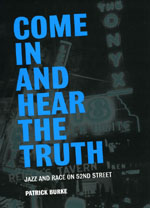Home » Jazz Articles » Book Review » Come In and Hear the Truth: Jazz and Race on 52nd Street
Come In and Hear the Truth: Jazz and Race on 52nd Street
 Come In and Hear the Truth: Jazz and Race on 52nd Street
Come In and Hear the Truth: Jazz and Race on 52nd Street Patrick Burke
Hardcover; 314 pages
ISBN: 987-0-22608071-0
University of Chicago Press
2008
The section of Manhattan's 52nd Street between 5th and 7th Avenues, fondly referred to as "The Street," holds iconic status as a major epicenter of jazz from Prohibition through World War II. Partrick Burke's book is a critical reexamination of 52nd Street's history with particular focus on racial relations, the social ethos of "bachelor" culture, the development and popularity of jazz genres and the aesthetic tension between jazz viewed as a "high" art form of spontaneous individual expression versus jazz as standardized popular (read: "low") entertainment.
Burke is especially interested in how the various stylistic representations of jazz—dixieland, swing and bop—influence and are influenced by racial stereotyping and in how black entertainers adopted individual, even contrary, strategies to undermine such perceptions. He suggests, for example, that violinist Stuff Smith combined improvisational prowess with showman's shtick in his early performances at the Onyx Club, while his successor, singer Maxine Sullivan, relied on John Kirby's classicized arrangements, European repertory and a gracious, cultivated stage demeanor.
Thoroughly researched using archives, newspapers, trade magazines, interviews, supplemented with period photos and a timeline of key clubs, the book is laid out in a series of case studies: the origins of the Onyx club (once a speakeasy and insider hangout for white "legit" musicians); the Spirits of Rhythm at the Onyx; singers and trumpeters Louis Prima and Wingy Manone (white musicians who appropriated and popularized black music) at the Famous Door; Smith then Sullivan at the Onyx; Count Basie at the Famous Door; clarinetist Joe Marsala at the Hickory House; the rise of bebop and the Dixieland Revival at Jimmy Ryan's.
More than a historical retread, Burke's treatment of the aforementioned themes makes for stimulating and informative reading.
< Previous
Perfect Strangers
Comments
Tags
For the Love of Jazz
 All About Jazz has been a pillar of jazz since 1995, championing it as an art form and, more importantly, supporting the musicians who create it. Our enduring commitment has made "AAJ" one of the most culturally important websites of its kind, read by hundreds of thousands of fans, musicians and industry figures every month.
All About Jazz has been a pillar of jazz since 1995, championing it as an art form and, more importantly, supporting the musicians who create it. Our enduring commitment has made "AAJ" one of the most culturally important websites of its kind, read by hundreds of thousands of fans, musicians and industry figures every month.























